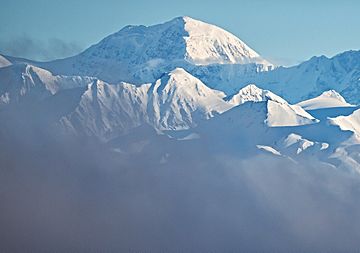Mount Moffit facts for kids
Quick facts for kids Mount Moffit |
|
|---|---|

Mount Moffit from the south
|
|
| Highest point | |
| Elevation | 13,020 ft (3,970 m) |
| Prominence | 3,970 ft (1,210 m) |
| Geography | |
| Location | Southeast Fairbanks Census Area, Alaska, U.S. |
| Parent range | Alaska Range |
| Climbing | |
| First ascent | August 12, 1942 by William Shand Jr., Benjamin Ferris Jr., and Sterling Hendricks |
Mount Moffit is a tall mountain peak in the Alaska Range. It is located in central Alaska, United States. This impressive mountain stands about 10 miles (16 km) east-southeast of Mount Hayes.
Mount Moffit is famous for its very steep sides. It rises sharply from the land around it. For example, its north face drops 7,400 feet (about 2,255 meters) in just 1.2 miles (2 km) horizontally. That's like going down more than two Empire State Buildings in a very short distance!
First Climbers and How the Mountain Got Its Name
The first people to successfully climb Mount Moffit were William Shand Jr., Benjamin Ferris Jr., and Sterling Hendricks. They reached the top on August 12, 1942. These three climbers had also been part of the first team to climb Mount Hayes the year before.
Sadly, William Shand Jr. died in a car accident shortly after this climb. People suggested naming Mount Moffit after him. However, there was a mistake. His name was accidentally given to a slightly lower peak to the south, which is now called Mount Shand.
Mount Moffit was officially named in 1950. The United States Geological Survey named it after Fred Howard Moffit (1874–1958). He was a geologist who worked in Alaska for many years. From 1903 to 1943, he studied Alaska's geology and mining. He wrote over fifty books and papers about his discoveries.
Climbing Mount Moffit
Mount Moffit is not climbed very often. This is because it is very hard to reach. The second time anyone climbed the peak was 33 years after the first ascent. M. Sallee and D. Buchanan made this climb in 1975.
The most common way to climb Mount Moffit is along its Northwest Ridge. This path is known as a very serious climb. It has features typical of Alaskan mountains, like corniced ridgelines. These are dangerous overhangs of snow and ice formed by wind.
The North Face of Mount Moffit is even more challenging. It was first climbed in 2007 by Jed Brown and Colin Haley.
Climate Around Mount Moffit
Mount Moffit is in a subarctic climate zone. This means it has very long, cold, and snowy winters. The summers are usually mild. This type of climate helps create the Trident Glacier, which surrounds the peak.
Temperatures on the mountain can drop below −20 °C (−4 °F). With the wind chill, it can feel even colder, below −30 °C (−22 °F). The best time to visit or climb Mount Moffit is usually from May through June. During these months, the weather is often more favorable.
Any rain or melting snow from the mountain flows into streams. These streams eventually join the Tanana River.
- Michael Wood and Colby Coombs, Alaska: a climbing guide, The Mountaineers, 2001.


